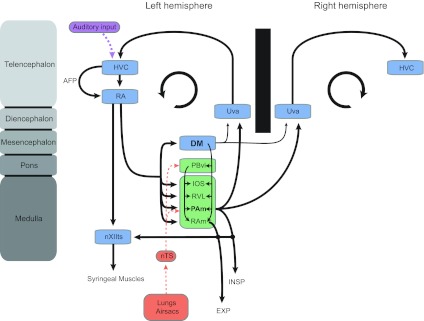Fig. 1.

Schematic representation of the avian song system and its relationship to the respiratory system. Illustration of the avian song system (shown in blue) and its anatomical connections with ponto-medullary respiratory nuclei (shown in green), which receive sensory information from putative mechano- and chemosensitive receptors in the lungs and air sacs (red) via the nucleus tractus solitarius (nTS). The song system also receives auditory input (purple) by way of nucleus HVC. The inspiratory nucleus parambigualis (PAm) receives strong projections from robust nucleus of the arcopallium (RA) and projects bilaterally back to the thalamic nucleus, uvaeformis (Uva), which itself projects directly back to HVC. Dorsomedial nucleus of the intercollicular complex (DM) also receives projections from RA and projects bilaterally back to Uva, but its projections are much weaker than PAm. DM projections to nXIIts are not shown for purposes of clarity. The nucleus parabrachialis ventrolateralis (PBvl), which is likely the avian homologue of the Kölliker-Fuse nucleus, does not receive direct projections from RA but is intimately tied with other structures in the respiratory brainstem. The respiratory areas PAm and retroambigualis (RAm) project directly to neurons in the tracheosyringeal branch of the hypoglossal nucleus (nXIIts), which contain the motor neurons that innervate the syrinx. The circular arrow in each hemisphere symbolizes the recurrent nature of the song motor circuit. AFP, anterior forebrain pathway; IOS, infra-olivaris superior; RVL, ventrolateral nucleus of the rostral medulla; EXP, expiration.
